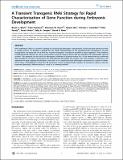| dc.contributor.author | Bjork, Bryan C. | |
| dc.contributor.author | Fujiwara, Yuko | |
| dc.contributor.author | Davis, Shannon W. | |
| dc.contributor.author | Qiu, Haiyan | |
| dc.contributor.author | Saunders, Thomas L. | |
| dc.contributor.author | Sandy, Peter | |
| dc.contributor.author | Orkin, Stuart H. | |
| dc.contributor.author | Camper, Sally A. | |
| dc.contributor.author | Beier, David R. | |
| dc.date.accessioned | 2011-06-01T13:35:27Z | |
| dc.date.available | 2011-06-01T13:35:27Z | |
| dc.date.issued | 2010-12 | |
| dc.date.submitted | 2010-05 | |
| dc.identifier.issn | 1932-6203 | |
| dc.identifier.uri | http://hdl.handle.net/1721.1/63160 | |
| dc.description.abstract | RNA interference (RNAi) is a powerful strategy for studying the phenotypic consequences of reduced gene expression levels in model systems. To develop a method for the rapid characterization of the developmental consequences of gene dysregulation, we tested the use of RNAi for “transient transgenic” knockdown of mRNA in mouse embryos. These methods included lentiviral infection as well as transposition using the Sleeping Beauty (SB) and PiggyBac (PB) transposable element systems. This approach can be useful for phenotypic validation of putative mutant loci, as we demonstrate by confirming that knockdown of Prdm16 phenocopies the ENU-induced cleft palate (CP) mutant, csp1. This strategy is attractive as an alternative to gene targeting in embryonic stem cells, as it is simple and yields phenotypic information in a matter of weeks. Of the three methodologies tested, the PB transposon system produced high numbers of transgenic embryos with the expected phenotype, demonstrating its utility as a screening method. | en_US |
| dc.description.sponsorship | Michigan Economic Development Corporation and the Michigan Technology Tri-Corridor (grant 085P1000815) | en_US |
| dc.description.sponsorship | National Institutes of Health (U.S) (R01HD34283) | en_US |
| dc.description.sponsorship | National Institutes of Health (U.S) (R37HD30428) | en_US |
| dc.description.sponsorship | National Institutes of Health (U.S) (F32HD045066) | en_US |
| dc.description.sponsorship | National Institutes of Health (U.S) (K12DE014528) | en_US |
| dc.description.sponsorship | National Institutes of Health (U.S) (RO1HD36404) | en_US |
| dc.description.sponsorship | National Institutes of Health (U.S) (R01MH081187) | en_US |
| dc.description.sponsorship | University of Michigan. Cancer Center (NIH grant CA46592) | en_US |
| dc.description.sponsorship | University of Michigan. Multipurpose Arthritis Center (NIH grant AR20557) | en_US |
| dc.description.sponsorship | University of Michigan. Center for Organogenesis | en_US |
| dc.description.sponsorship | University of Michigan. Gut Peptide Research Center (NIH grant DK34933) | en_US |
| dc.description.sponsorship | University of Michigan. Nathan Shock Center for the Biology of Aging (NIH grant P30AG013283) | en_US |
| dc.language.iso | en_US | |
| dc.publisher | Public Library of Science | en_US |
| dc.relation.isversionof | http://dx.doi.org/10.1371/journal.pone.0014375 | en_US |
| dc.rights | Creative Commons Attribution | en_US |
| dc.rights.uri | http://creativecommons.org/licenses/by/2.5/ | en_US |
| dc.source | PLoS | en_US |
| dc.title | A Transient Transgenic RNAi Strategy for Rapid Characterization of Gene Function during Embryonic Development | en_US |
| dc.type | Article | en_US |
| dc.identifier.citation | Bjork BC, Fujiwara Y, Davis SW, Qiu H, Saunders TL, et al. (2010) A Transient Transgenic RNAi Strategy for Rapid Characterization of Gene Function during Embryonic Development. PLoS ONE 5(12): e14375. doi:10.1371/journal.pone.0014375 | en_US |
| dc.contributor.department | Koch Institute for Integrative Cancer Research at MIT | en_US |
| dc.contributor.approver | Sandy, Peter | |
| dc.contributor.mitauthor | Sandy, Peter | |
| dc.relation.journal | PLoS ONE | en_US |
| dc.eprint.version | Final published version | en_US |
| dc.identifier.pmid | 21179568 | |
| dc.type.uri | http://purl.org/eprint/type/JournalArticle | en_US |
| eprint.status | http://purl.org/eprint/status/PeerReviewed | en_US |
| dspace.orderedauthors | Bjork, Bryan C.; Fujiwara, Yuko; Davis, Shannon W.; Qiu, Haiyan; Saunders, Thomas L.; Sandy, Peter; Orkin, Stuart; Camper, Sally A.; Beier, David R. | en |
| mit.license | PUBLISHER_CC | en_US |
| mit.metadata.status | Complete | |
